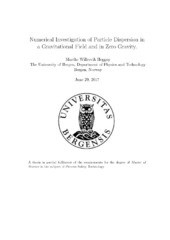| dc.description.abstract | Combustible solid particles dispersed in gas has previously been discovered to be a precursor to a potential dust explosion. Consequently, a growing interest on the subject has been observed in recent years. Numerous experimental investigations have been performed on dust dispersion, but there are still some challenging issues when investigating the dust cloud combustion characteristics. Therefore, zero gravity condition (g = 0) have been suggested to be an ”ideal” condition for dust cloud explosion research. The aim of this thesis is to supplement data from previous numerical and experimental studies that have been performed on the dispersion process in a modified Hartmann tube, and investigate the particle dispersion in this ”ideal” condition. Using the computational fluid dynamics (CFD) in form of the simulation software Star CCM+ the dispersion of the solid particles was investigated in this research. The Eulerian-Lagrangian approach was used to simulate the multiphase flow of a small amount of particles in gas. Different models were used in the CFD code to observe the effect on the movement of the particles. The computer aided design (CAD) model used in the simulations is based on the shape and dimensions for a standard modified Hartmann tube. The simulations were run in normal condition and in zero gravity condition. In addition, different inlet velocities, amount of particles and particle characteristics were varied. Finally, it was investigated how the coefficient of restitution, shear lift force and pressure gradient force influenced the particle dispersion. In the course of the research it was discovered that the vertical velocity profile of the fluid flow distribution was non-symmetric, which correlates with similar previous numerical simulation performed on a single particle. Two main particle movement paths immediately after gas injection initiation were discovered. One of these paths also correlated with results from earlier work done. After running the simulations for about 100 ms, an approximately uniform particle cloud could be found with the help of volume fraction monitors. In normal condition the particle cloud settled as the velocity decayed and sedimented at the tube bottom. For the suggested ”ideal” condition, the particles stayed in a dispersed cloud during the whole simulation. An important discovery was how the dispersion got affected by the gas inlet velocity and the apparatus geometry. Gas injection velocities under 40 m/s did not generate a uniform particle cloud before the settling process started. When smaller particles were used, the results showed that the particle velocity, velocity decay time and dispersion time increased. When increasing the amount of particles present, no significant effect on the movement was found. Three values for the restitution coefficient were tested and the results showed major deviations whether the particle-wall collisions were elastic or inelastic. As the collisions went from totally elastic to fully inelastic, the particle velocities decreased. The influence of the shear lift force, modelled using two approaches (Saffman and Sommefeld) was investigated. A minor increase in particle velocity and particle lifting was observed for the Saffman approach. Finally, the pressure gradient force was investigated by comparing the results with a simulation where the force was enabled. Nevertheless, no significant differences were detected in this case. | en_US |
